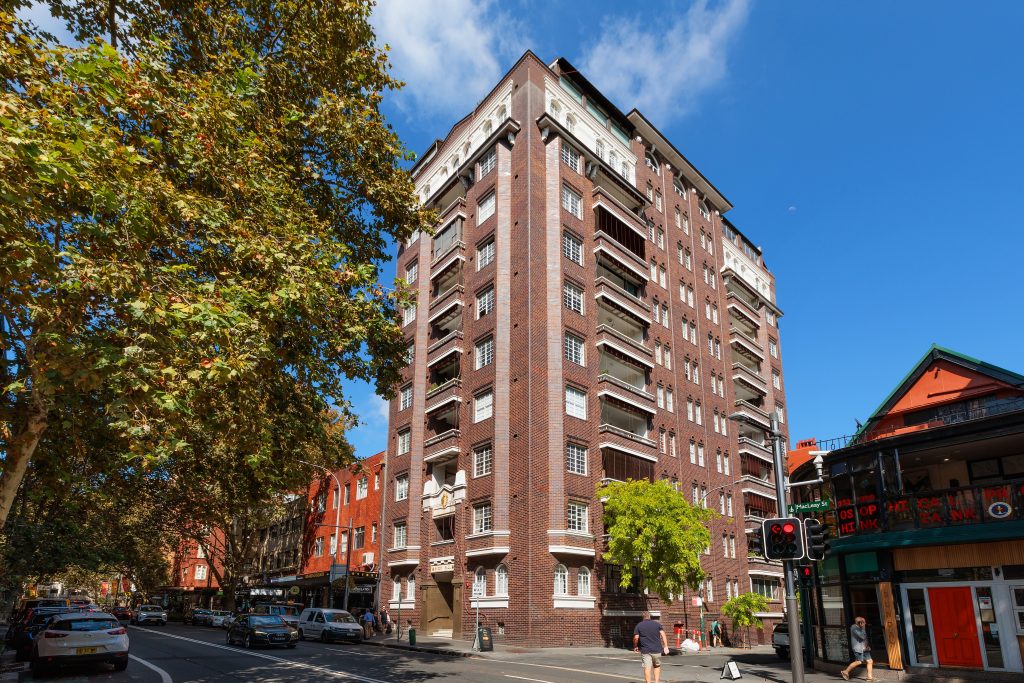BYRON HALL: FIT FOR A LORD

CLAUD HAMILTON, that’s Claud without an e, was a prolific early 20th century architect/developer.
He designed Byron Hall Flats, 97-99 Macleay Street, Potts Point, in 1929 using the inter-war classical free style.
Apartment 18 is for sale through Jason Boon & Geoff Cox
The term, the inter-war classical free style denotes use of classical features such Roman arches, proportionally squared windows and even a gold leaf palmette acroterion (a Grecian sculptural embellishment) emblazoned on its façade.
This free, eclectic style was popular between 1919-1939 and was less formal than former 18th and 19th century buildings which had also adopted some neo-classical elements.
It is not known why the building is named Byron Hall although Lord Byron (1788-1824), an eccentric poet, had a strong relationship with classical Greecian, empires: it may have referenced him.
Claud Hamilton also designed nearby Regent’s Court in Springfield Avenue (1925), the Savoy apartments (1919), St John’s Flats, Darlinghurst Road (1916), Wirringulla (1927) and Kaloola (1927), both in St Neot Avenue, Normandy House, Darlinghurst Road (1916), Versailles (1926) and Kenilworth (1920) amongst others.
Apartment four has many original features including its wooden floors, air vents, terrazzo windowsill, high ceilings and door architraves.
Hamilton’s professional relationship and commercial partnership over the Byron Hall Flats with Mr. James, developer, soured. It ended up in the High Court of Australia. They’d both agreed to buy the site in August 1926 for £11,250 to build flats. They formed a company designed to hold the property and profits in trust for each of them based on a fair split of their individual investments. But costs went over the budget of £45,000 and a dispute arose: how much profit should each now receive? Was there still a binding trust contract? No, said the High Court unanimously in 1930; they were “co-adventurers” [case reference HCA 8, 45 CLR 37]. Hamilton was thus directly entitled to his full share of the profits based on their original but loose “arrangement”, ie., based on 40% of his costs, regardless of cost overruns.
Until the 1950s Byron Hall was serviced self-contained flats all owned by Mr. James.
Maids lived on the top floor and a caretaker resided on the ground floor, where original wooden letterboxes with gold numbering are still used. The original foyer name board still exists in the board room.
When ‘flats’ first became popular there were serious doubts about their convenience. Some owners had experienced problems with the flats in other buildings but on the 2nd June 1943 The Sydney Morning Herald reported that “Mr. W.H James, owner of Byron Hall Flats, Potts Point, yesterday denied that he, like some other owners of flats, had experienced any shortage of coal to provide central heating and a hot water supply there for the 43 flats. Mr. James said that hot water was supplied without interruption and for central heating between 6am and 8am and 4pm and 10pm.”
Unsurprisingly, almost a century later, there is still no shortage of hot water – or occupiers.
By
Andrew Woodhouse
Heritage Solutions





